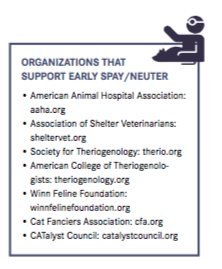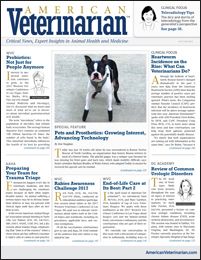New Advice on Sterilizing Kittens: Earlier Is Better
New recommendations support kitten spay/neuter by 5 months of age. Here’s why.
Conventional wisdom states that kittens should be spayed or neutered no earlier than 6 months of age, but feline medicine specialists now say that an earlier age for the surgery benefits cats, owners, and veterinarians alike.
The Veterinary Task Force on Feline Sterilization, which comprises 11 experts representing the breeding, shelter, and behavior communities, spent a year reviewing and discussing all available literature to reach the recommendation—released at the 2017 North American Veterinary Community Conference—to sterilize kittens by 5 months of age.1
The American Association of Feline Practitioners (AAFP) has endorsed the recommendation, stating that it parallels its own position statement on early spay and castration.2 “At the moment, most of the data indicate that we have effective anesthetic protocols for younger patients,” says AAFP President Lauren Demos, BVMS, HonsBSc, resident ABVP (Feline). “As we start to piece [together] what we do have, there’s a huge suggestion that we can move this time for spays and neuters forward and do better for the cat population and cat owners.”
Benefits of Early Sterilization
As a species, cats tend to be underrepresented in scientific literature, especially in terms of case controlled studies, and Dr. Demos notes the need for more data. The task force’s review of available study results, however, found that early neutering in cats is not associated with serious health problems and does not appear to adversely affect skeletal, physical, or behavioral development.
Surgery at this earlier age takes less time and permits better visualization of organs because younger kittens have less body fat. Kittens are also typically anesthetized for a shorter time because surgery goes more quickly, so the recovery period is also shorter. Kittens weighing at least 1 kg can be sterilized safely as early as 6 weeks of age.
Julie Levy, DVM, PhD, DACVIM, task force member and professor of shelter medicine at the University of Florida College of Veterinary Medicine, notes that kittens bleed less than older cats, the trauma to their tissue is not as great, and they are highly responsive to pain medication, making it easier to keep them comfortable postoperatively. Surgical techniques such as ovarian pedicle increase surgical efficiency.
The main difference between spaying kittens at 6 months of age versus 4 to 5 months of age is the perioperative environment, Dr. Levy says. Young kittens have a higher risk of becoming chilled or hypoglycemic.
“That means we feed them a few hours before surgery so they don’t become hypoglycemic, and we have a big focus on keeping them warm,” she says. “This involves making sure the air temperature in the rooms is warm, they’re not kenneled in a cold place before they’re anesthetized, all the surfaces they’re on are warm, and the whole procedure is efficient so they wake up quickly.”
Spaying or neutering earlier means that owners also can avoid the potential risk for unwanted litters. Many pet owners are surprised to learn that kittens as young as 4 months of age, and potentially even 3 months, are capable of reproducing.
“Cats, as a species, are the epitome of evolution,” Dr. Demos says. “They are made to reproduce. They’re great at surviving an environment and being prolific reproducers. That works in their favor most of the time, but in modern society, it’s less than ideal.”
Sterilization also eliminates the unpleasant behaviors that accompany feline sexual maturity, such as vocalizing, urine marking, and roaming. Multiple studies have even suggested that neutered animals live longer than intact ones, possibly because these animals are less likely to roam and fight.3,4 A medical benefit for spayed or neutered cats is a reduced risk for mammary tumors later in life.5-8
“There’s also a benefit if you look at it from the approach that we tend to do a kitten vaccine series and generally wrap that up by 16 weeks of age,” Dr. Demos says. “If we can tie an early spay or neuter in with that rather than asking a client to come back 2 months later for spay or neuter surgery, we might get better compliance with cats actually becoming sterilized.” This could mean better control of the feline population because of fewer unwanted litters or that fewer cats would end up in shelters because of unwanted behavior problems related to a lack of sterilization, such as urine marking and spraying.9
Lingering Oppostition

Some veterinarians still worry that sterilization before 6 months of age is too early. According to the AAFP website, concerns include the safety of anesthesia and surgery in young kittens as well as potentially detrimental long-term effects on development. Opponents cite obesity, a decreased immune
response, delayed closure of the physes of long bones, and predisposition to obstructive lower urinary tract disease as possible harmful effects.
There are certainly always going to be concerns, notes Dr. Demos. “When we discuss making a recommendation that’s broad and sweeping for patients, there will always be people on each side of the fence, and that’s valid,” she says. “One of the reasons that we picked 5 months as an initiative, rather than potentially 2.5 or 3.5 months, is that we want to take this slowly, but if performing sterilization just 1 month earlier can reduce the risk for breeding and reduce the risk for offspring, then we’ve made some impact.”
Dr. Levy hopes that the American Veterinary Medical Association (AVMA), will also officially support the initiative. “[The] AVMA has several position statements that address the appropriateness of pediatric spay and neuter,” Dr. Levy says. “I think when the science is displayed on this topic for cats,
there is no reason not to embrace it.”
Kim Campbell Thornton has been writing about dogs and cats for 32 years. She is the award-winning author of more than 2 dozen books and hundreds of articles on pet care, health and behavior.
References:
- Association of Shelter Veterinarians’ Veterinary Task Force to Advance Spay-Neuter. Special report: The Association of Shelter Veterinarians’ 2016 veterinary medical care guidelines for spay-neuter programs. JAVMA. 2016;249(2):165-188.
- American Association of Feline Practitioners. AAFP Position statement: Early spay and castration. AAFP website. http://www.catvets.com/public/PDFs/PositionStatements/EarlySpay&Neuter.pdf. Accessed April 28, 2017.
- Root Kustritz MV. Early spay—neuter: clinical considerations. Clin Tech Small Anim Pract. 2002;17:124-128.
- Hoffman JM, Creevy KE, Promislow DEL. Reproductive capability is associated with lifespan and cause of death in companion dogs. PLOS One. 2013;8(4):e61082.
- Dorn CR, Taylor DO, Schneider R, et al. Survey of animal neoplasms in Alameda and Contra Costa Counties, California. II. Cancer morbidity in dogs and cats from Alameda County J Natl Cancer Inst. 1968;40(2):307-318.
- Hayes HM Jr, Milne KL, Mandell CP. Epidemiological features of feline mammary carcinoma. Vet Rec. 1981;108(22):476-479.
- Misdorp W, Romijn A, Hart AAM. Feline mammary tumors: A case-control study of hormonal factors. Anticancer Res. 1991;11(5)1793-1797.
- Overley B, Shofer FS, Goldschmidt MH, et al. Association between ovarihysterectomy and feline mammary carcinoma. J Vet Intern Med. 2005;19(4):560-563.
- Glickman LT, Beck AM, McCabe GP, Ecker C. Risk factors for relinquishment of cats to an animal shelter. JAVMA. 1996;209(3):582-588.
